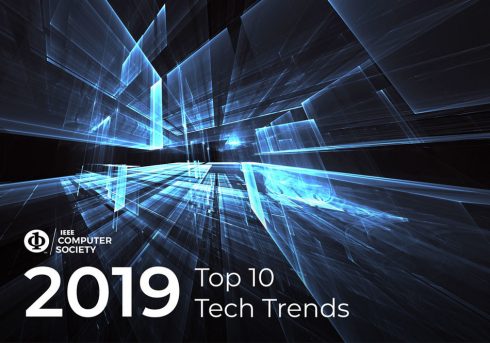
The IEEE Computer Society (IEEE-CS) has released its top 10 technology trends for the upcoming year. The trends are based on what the technology experts believe will be the most widely adopted and meant to forecast the future for organizations.
“The Computer Society’s predictions, based on an in-depth analysis by a team of leading technology experts, identify top technologies that have substantial potential to disrupt the market in the year 2019,” said Hironori Kasahara, IEEE Computer Society president. “The technical community depends on the Computer Society as the source of technology IP, trends, and information. IEEE-CS predictions represent our commitment to keeping our community prepared for the technological landscape of the future.”
According to the IEEE-CS, the top 10 trends we can expect for 2019 are:
- Deep learning accelerators such as GPUs, FPGAs and TPUs. According to the IEEE-CS, many companies are developing their own accelerators, and deploying them to the edge bringing the power of machine learning to IoT devices and appliances.
- Assisted transportation such as automated assistance solutions are being placed more and more in personal and municipal devices. It will still be some time until we see self-driving vehicles, the IEEE-CS explained.
- The Internet of Bodies refers to IoT and self-monitoring technologies such as fitness trackers and smart glasses. In addition, the IEEE-CS explained these devices are also moving “inside the human body” with digital pills becoming mainstream and body-attached, implantable devices.
- Social credit algorithms “use facial recognition and other advanced biometrics to identify a person and retrieve data about that person from social media and other digital profiles for the purpose of approval or denial of access to consumer products or social services,” the IEEE-CS wrote in its announcement of the trends.
- Advanced materials and devices for sensors, actuators and wireless communications will start coming to healthcare, packaging, and applications, according to the IEEE-CS. The organization explained it will also have an impact with IoT devices and immersive computing.
- Active security protection will be more widely adopted as hackers become more sophisticated. This new type of security protection will include hooks and machine-learning mechanisms.
- Virtual reality and augmented reality has already become mainstream in the gaming industry, but the IEEE-CS expects it to go beyond games and come to education and engineering industries. “However, there has been a Catch-22 in that there is a lack of applications resulting from the high cost of entry, yet the cost has stayed high due to a lack of applications. With advertisements for VR headsets appearing during prime-time television programs, we may have finally reached a tipping point,” the organization wrote.
- Chatbots are already being used for basic customer service solutions and in operating systems for providing personal assistants, however the IEEE-CS sees the industry looking for more ways to expand the use of chatbot applications.
- Automated voice spam prevention is emerging as a way to block spoofed caller ID and intercept questionable calls so that users don’t have to worry about ignoring phone calls and missing actual emergency calls.
- Technology for humanity will be used to improve societal issues such as agriculture, drought, food supplies and health services through the use of machine learning, robots and drones. “Some of these activities have already started, but we predict an increase in adoption rate and the reporting of success stories in the next year,” IEEE-CS wrote.
In addition, the organization revealed some technologies it considers promising, but won’t be widely adopted until after 2019. For instance:
- Digital twins are software representations of assets designed to understand, predict and optimize performance, according to the organization. While Gartner included digital twins on its top 10 technology trends, the IEEE-CS believes there are still some use cases where digital twins will take time to be adopted such as in the healthcare industry.
- Real-time ray tracing (RT) is a technique for rendering computer graphics. “In 2018, we witnessed the debut of a consumer product family with RT capabilities. In the next couple of years we expect to see incremental iterations until true RT is widespread,” the IEEE-CS wrote.
- Serverless computing such as AWS Lambda, Google Cloud Functions and Azure Functions puts the responsibility of managing resources in the hands of the service provider. “End users can focus on the functions and don’t have to pre-allocate instances or containers or manage them explicitly,” according to the IEEE-CS. While the term serverless computing is popping up more recently, the IEEE-CS doesn’t expect to see significant adoption for another couple of years.
Lastly, the IEEE-CS declared that technologies like Kubernetes, Docker and edge computing have already reached broad adoption.





